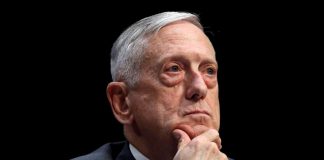SEPTEMBER 21, 2019
 Major General Juergen-Joachim von Sandrart (L) of the German Bundeswehr and Colonel Joe Hilbert of the US Army arrive for a press briefing during the Allied Spirit X international military exercises at the U.S. 7th Army training center on April 9, 2019 near Hohenfels, Germany. Approximately 5,600 soldiers, including around 1,300 from the U.S. and the rest from Denmark, Finland, Germany, Israel, Italy, Lithuania, Moldova, Netherlands, Poland, Slovakia, Spain, Sweden, Turkey, and the United Kingdom are taking part in the nearly three-week long exercises. – Photo by Lennart Preiss/Getty Images
Major General Juergen-Joachim von Sandrart (L) of the German Bundeswehr and Colonel Joe Hilbert of the US Army arrive for a press briefing during the Allied Spirit X international military exercises at the U.S. 7th Army training center on April 9, 2019 near Hohenfels, Germany. Approximately 5,600 soldiers, including around 1,300 from the U.S. and the rest from Denmark, Finland, Germany, Israel, Italy, Lithuania, Moldova, Netherlands, Poland, Slovakia, Spain, Sweden, Turkey, and the United Kingdom are taking part in the nearly three-week long exercises. – Photo by Lennart Preiss/Getty Images
The Army Chief of Staff said the army must bolster its presence around the world. It’s not just a show of power, but rather a quicker response to ever-changing global events. These range from boots on the ground to crews working behind computers to counter cyber attacks—and everything in between.
Gen. James McConville said he wants mass deployments of troops around the globe to be ready, rather than sitting at standby from a base in the United States.
“It’s wonderful that we have a brigade, sitting maybe at Fort Campbell, that’s at the highest level of readiness,” McConville told the Army Times. “But we also need to get that brigade to where we need … and that may be by airlift, it may be by sealift.”
In other words, he wants troops stationed in Europe or other fronts already, instead of having to fly them across the Atlantic Ocean or other vast seas at moment’s notice and in a time of need. Whereas it’s nice to have troops at the ready stateside, it helps the Army’s mission to have forces ready closer to any potential conflicts.
Most of this millenium has been about readiness for the Middle East with ongoing battles. Now the mission has spread to smaller pockets to combat not only physical forces, but local transportation and cyber threats.
The Army expects more rapid deployment of forces in the coming years, and it wants to be more proactive instead of reactive.
“We have to be able to deploy it there,” McConville said. “That is what we talk about with strategic readiness and that is a concern that I think at my level, I need to really go after.”
Gen. McConville added that readiness forces would be deployed in regions that coincide with larger strategic moves, which include some remote parts of the globe not easily accessible from the U.S. mainland.
“What I think you’ll see is exercises being planned in the regions that are priorities under the National Defense Strategy,” McConville said. “So, heck, you know maybe larger exercises in the European area, maybe larger exercises in the Indo-Pacific area.”
Retired Lt. Gen. Ben Hodges guided the Army’s European forces from 2014-17, and he believes that even a new frontline defense will be challenged from other countries.
“I would assume some of that will happen in a crisis and I would expect some of it to even happen during exercises,” Hodges told the Army Times. “Cyber protection for seaports and airports in Europe and for rail networks is just as important as having tanks and airplanes, because we’re all going to depend on French, Belgian, German, Polish transportation infrastructure.”
As for becoming a large-scale force, McConville said his job is to make sure troops will need to be where they need to be ahead of time, rather than rushing them there thousands of miles away if something happens.
“They realize that we have to move our forces, so we can dynamically move them around the globe according to where their requirements are. Part of our job is laying out what requirements are,” the general said.
The movement isn’t just limited to the European theater, but to locales in the Pacific and Asian countries, according to the Times.
Courtesy/Source: Newsweek










































































































